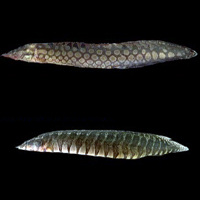Unravelling taxonomic ambiguity of the Mastacembelidae in the Mekong Delta (Vietnam) through DNA barcoding and morphological approaches

Accepted: 1 October 2020
HTML: 363
All claims expressed in this article are solely those of the authors and do not necessarily represent those of their affiliated organizations, or those of the publisher, the editors and the reviewers. Any product that may be evaluated in this article or claim that may be made by its manufacturer is not guaranteed or endorsed by the publisher.
Authors
Morphological-based species identification can be problematic for a comparative worldwide survey if taxonomic keys are limited and inconsistent, as illustrated in the family Mastacembelidae. This study combined DNA barcoding and morphological methods to test species identification of Mastacembelidae in the Mekong Delta with emphasis on taxonomic ambiguity of the precise identification of the fish locally known as chach bong. Fish specimens were collected from fishermen in different regions of the delta. Five presumed species within two genera were recorded. Samples were morphologically measured for morphometric and meristic traits. Representative samples of each species were sequenced at the cytochrome c oxidase subunit I (COI) gene. The number of dorsal fin spines and general morphological appearance are distinguishable among the five presumed species. However, morphometric measurements overlapped between Macrognathus semiocellatus and Macrognathus siamensis. K2P distances based on COI sequences among species were high, ranging from 12.4% to 18.7%. All individuals were separated into monophyletic groups of species, clustered into Mastacembelus and two Macrognathus lineages. Chach bong should be recognized as Mastacembelus favus and not Mastacembelus armatus as previously classified. No Mastacembelus armatus was recorded in the Mekong Delta. GenBank sequences of Mastacembelus armatus formed a sister relationship to Mastacembelus favus although both have the same range of number of dorsal fin spines and similar reticulated patterns on the body. Misidentification between these two species has been widely recorded in international databases of species taxonomy and DNA barcodes. Nonetheless, their genetic distance (12.4%) is higher than conspecific distances of samples from other regions, indicating the two species can be differentiated by DNA barcoding.
Supporting Agencies
This study was funded by the Can Tho University Improvement Project VN14-P6, supported by Japanese ODA loan.How to Cite
PAGEPress has chosen to apply the Creative Commons Attribution NonCommercial 4.0 International License (CC BY-NC 4.0) to all manuscripts to be published.


 https://doi.org/10.4081/tz.2020.72
https://doi.org/10.4081/tz.2020.72



